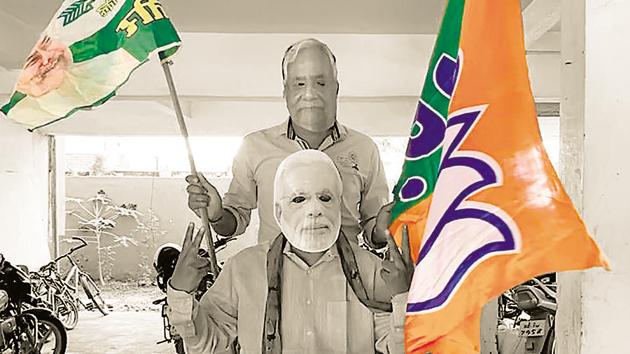Why Tejashwi failed to break the glass ceiling | Opinion
How did the National Democratic Alliance (NDA), then, manage to turn the rising tide against Kumar? Why could Yadav not build on the groundswell of support evident in his rallies to trounce the NDA? And finally, where did the exit polls go wrong?
Exit polls predicted a landslide for the Rashtriya Janata Dal (RJD)-led Mahagatbandhan (MGB) of Opposition parties. The only quibble was the quantum of the RJD victory. These findings gained greater credence since those covering the ground reported deep resentment and anger against the incumbent Nitish Kumar. We were told that Tejashwi Yadav’s plank of economic justice that covered themes as kamai (employment), dawai (medical facilities), padhai (education), sichai (irrigation) and mehengai (price rise) found great resonance among the voters, and that the young voters in Bihar were adamant for a change of guard.

How did the National Democratic Alliance (NDA), then, manage to turn the rising tide against Kumar? Why could Yadav not build on the groundswell of support evident in his rallies to trounce the NDA? And finally, where did the exit polls go wrong? These three questions are critical to understanding the 2020 elections in Bihar.
First, the analysis of provisional results from the Election Commission of the three phases indicates a clear pattern. Demographically, phase one, comprising 71 seats in south Bihar, had a higher concentration of Dalit voters. The 94 seats in central Bihar polled during the second phase had a higher proportion of Extreme Backward Classes (EBCs). The remaining 78 seats that polled in the final phase had a larger share of the Muslim population. The MGB has outperformed the NDA in the first phase. It seems that the Dalit vote in this region got divided between the NDA, the Lok Janshakti Party (LJP), and the Left Front (which, as an MGB constituent, contested a large number of seats in this phase). In addition, the pre-poll survey conducted by Lokniti-CSDS suggested that while the JD(U) voters were seamlessly transferring their support to NDA candidates and Nitish Kumar, BJP voters were not wholeheartedly backing Kumar.
This confusion within the BJP’s rank and file was created due to the widespread belief that the party propped up Chirag Paswan as a front to dislodge Nitish Kumar. The LJP was largely contesting on seats that the JD(U) was a contender and it also fielded some high-profile ex-BJP members. There was a late realisation within the BJP leadership that if these rumors persisted, they may have a tough time retaining the state. So they left no stone unturned in reminding voters that no matter how many seats the BJP won, Nitish Kumar was going to be CM. And this is likely to be the most important reason that there was a turnaround in the second phase, in which the NDA managed a slight edge over the MGB. It then went on to completely dominate the third phase.
Second, while there was clearly some resentment against Nitish Kumar owing to his perceived non-performance in his last term, anti-incumbency sentiments were not sharp enough for the erstwhile NDA voters to switch sides. This may be because Yadav’s promise of one million jobs and his focused campaign led the crowd to throng rallies, but they could not bring themselves to trust him enough to vote for MGB. He does not seem to have inspired confidence outside his party’s base among Yadav and Muslim constituents. Even the ticket distribution of RJD couldn’t cast a wider social net; at least 50% of candidate nominations went to members of these communities.
In addition, the prospect of MGB sweeping in the first phase may have helped the NDA to consolidate its support base with the spectre of the return of a jungle raj of the Lalu Prasad era. The NDA succeeded in counter-consolidating non-Yadav and non-Muslim communities. While the RJD itself did not do spectacularly in the second and third phases, it was further pulled down by a very poor show by Congress as well as the fragmentation of Muslim voters in the Kosi-Seemanchal region.
Finally, why were exit polls, especially Axis-My-India with an impeccable track record of correctly predicting outcomes in the past few years, off the mark this time? The most important reason seems to be women voters — a constituency carefully nurtured by Nitish Kumar over the years through various policies including the prohibition on the sale of liquor in the state. This constituency steered Nitish Kumar to the post of chief minister for the first time in the October 2005 elections. And since then, anecdotal evidence suggests, there is no match to Kumar’s popularity among this segment in Bihar.
Women turnout exceeded men turnout by five percentage points — a factor that remained unaccounted for in most exit polls. Women were underrepresented in most exit polls. The Axis-My-India poll, which polled over 63,000 voters, had only 31% women respondents. To be fair to pollsters, they were mindful of this problem and extrapolated the data (a valid technique in survey research) to overcome this bias. But this was not enough.
The Bihar verdict confirms that elections are won and lost during the campaign. Given the complexities involved, rather than predicting outcomes, our focus must remain on understanding the opportunities and constraints each campaign reflects — in this case, it is a story of the glass ceiling Tejashwi Yadav couldn’t break and the possible return of Nitish Kumar against all odds.






